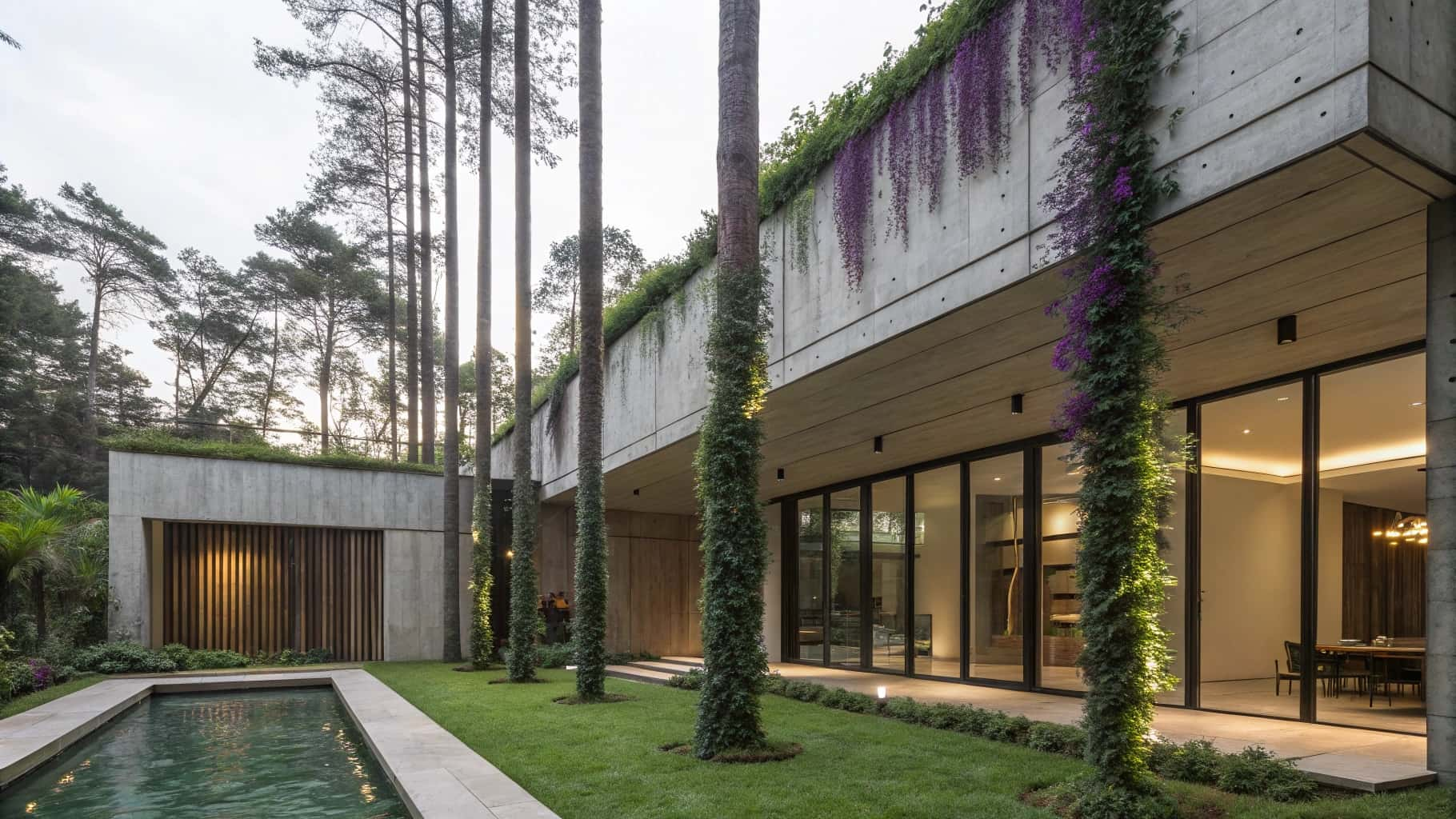A carbon-neutral mansion is a luxurious residence designed to have a net-zero carbon footprint, meaning that the total amount of carbon dioxide emissions produced by the mansion is balanced by an equivalent amount of carbon offset or reduction. This concept is rooted in the broader movement toward sustainability and environmental responsibility, which has gained significant traction in recent years. Carbon-neutral mansions are not merely about opulence; they embody a commitment to reducing environmental impact while providing a high standard of living.
These homes often incorporate advanced technologies and innovative design principles that prioritize energy efficiency, renewable energy sources, and sustainable materials. The design of a carbon-neutral mansion typically includes features such as solar panels, energy-efficient appliances, and advanced insulation techniques. These elements work together to minimize energy consumption and reduce reliance on fossil fuels.
Additionally, many carbon-neutral mansions are equipped with systems for rainwater harvesting and greywater recycling, further enhancing their sustainability. The goal is to create a living space that not only meets the needs of its inhabitants but also respects and preserves the environment. As climate change becomes an increasingly pressing issue, the appeal of carbon-neutral mansions is likely to grow, attracting environmentally conscious buyers who seek luxury without compromising their values.
The Benefits of Carbon-Neutral Living
Living in a carbon-neutral mansion offers numerous benefits that extend beyond mere environmental considerations. One of the most significant advantages is the potential for substantial cost savings over time. By utilizing renewable energy sources such as solar or wind power, homeowners can significantly reduce their utility bills.
Energy-efficient appliances and smart home technologies further contribute to lower energy consumption, leading to reduced operational costs. In many cases, government incentives and tax credits for renewable energy installations can also offset initial investment costs, making carbon-neutral living not only environmentally friendly but also economically viable. Beyond financial savings, carbon-neutral living promotes a healthier lifestyle.
Homes designed with sustainability in mind often feature improved indoor air quality due to the use of non-toxic materials and better ventilation systems. This can lead to enhanced well-being for residents, reducing the risk of respiratory issues and other health problems associated with poor indoor environments. Furthermore, the psychological benefits of living in a space that aligns with one’s values cannot be overstated.
Homeowners who prioritize sustainability often report higher levels of satisfaction and fulfillment, knowing that their lifestyle choices contribute positively to the planet.
How to Achieve Carbon Neutrality in a Mansion
Achieving carbon neutrality in a mansion involves a multi-faceted approach that encompasses energy efficiency, renewable energy integration, and sustainable practices. The first step is conducting an energy audit to assess the current energy consumption patterns and identify areas for improvement. This audit can reveal opportunities for upgrading insulation, sealing leaks, and replacing outdated appliances with energy-efficient models.
Implementing these changes can significantly reduce the mansion’s overall energy demand, laying the groundwork for further sustainability efforts. Once energy efficiency measures are in place, the next step is to incorporate renewable energy sources. Solar panels are among the most popular options for residential properties, as they can generate electricity from sunlight, significantly reducing reliance on grid power.
In some cases, homeowners may also consider wind turbines or geothermal heating systems, depending on their location and specific energy needs. Additionally, investing in battery storage systems allows homeowners to store excess energy generated during peak production times for use during periods of low generation. Finally, engaging in carbon offset programs—such as reforestation projects or renewable energy credits—can help balance any remaining emissions, achieving true carbon neutrality.
The Cost of Building and Maintaining a Carbon-Neutral Mansion
The financial implications of building and maintaining a carbon-neutral mansion can vary widely based on several factors, including location, design choices, and the technologies employed. Initially, the construction costs may be higher than traditional building methods due to the premium associated with sustainable materials and advanced technologies. For instance, high-performance insulation, triple-glazed windows, and renewable energy systems can all contribute to increased upfront expenses.
However, these costs should be viewed in the context of long-term savings on energy bills and maintenance costs. Maintenance costs for carbon-neutral mansions can also differ from conventional homes. While many sustainable technologies require minimal upkeep, certain systems—such as solar panels—may need periodic cleaning and inspection to ensure optimal performance.
Additionally, homeowners may need to invest in ongoing education about sustainable practices to maximize their home’s efficiency. Despite these considerations, many owners find that the benefits of reduced utility costs and increased property value outweigh any additional expenses associated with maintaining a carbon-neutral mansion.
Common Misconceptions About Carbon-Neutral Living
Despite the growing popularity of carbon-neutral living, several misconceptions persist that can deter potential homeowners from embracing this lifestyle. One common myth is that carbon-neutral homes are inherently less luxurious or comfortable than traditional mansions. In reality, many carbon-neutral designs incorporate high-end finishes and state-of-the-art amenities that rival their conventional counterparts.
The focus on sustainability does not preclude luxury; rather, it enhances it by creating spaces that are both aesthetically pleasing and environmentally responsible. Another misconception is that achieving carbon neutrality requires significant lifestyle sacrifices or compromises on convenience. While it is true that some adjustments may be necessary—such as adopting more efficient habits or utilizing smart home technology—many homeowners find that these changes lead to a more streamlined and enjoyable living experience.
For example, smart thermostats can optimize heating and cooling schedules based on occupancy patterns, enhancing comfort while minimizing energy use. By dispelling these myths, potential buyers can better appreciate the true value of carbon-neutral living.
The Role of Renewable Energy in Carbon-Neutral Mansions
Renewable energy plays a pivotal role in achieving carbon neutrality in mansions by providing clean power sources that significantly reduce greenhouse gas emissions. Solar energy is perhaps the most widely recognized form of renewable energy utilized in residential settings. Photovoltaic (PV) panels convert sunlight into electricity, which can be used to power everything from lighting to heating systems within the home.
In addition to solar panels, homeowners may also explore solar thermal systems for water heating or even small-scale wind turbines if local regulations permit. The integration of renewable energy not only contributes to reducing a mansion’s carbon footprint but also enhances its resilience against fluctuating energy prices and grid outages. By generating their own electricity, homeowners can insulate themselves from rising utility costs while ensuring a reliable power supply during emergencies.
Furthermore, advancements in battery storage technology allow homeowners to store excess energy generated during sunny days for use during nighttime or cloudy periods, maximizing the efficiency of their renewable systems.
The Importance of Sustainable Materials and Design in Carbon-Neutral Mansions
Sustainable materials and thoughtful design are essential components of any carbon-neutral mansion. The choice of building materials can significantly impact both the environmental footprint of construction and the long-term sustainability of the home itself. For instance, using reclaimed wood or recycled steel reduces the demand for new resources while minimizing waste.
Additionally, selecting low-VOC (volatile organic compounds) paints and finishes contributes to healthier indoor air quality by reducing harmful emissions. Design plays an equally critical role in achieving carbon neutrality. Passive design strategies—such as orienting windows for optimal natural light and ventilation—can reduce reliance on artificial heating and cooling systems.
Incorporating green roofs or living walls not only enhances aesthetic appeal but also provides insulation and improves air quality by filtering pollutants. By prioritizing sustainable materials and innovative design principles, architects and builders can create luxurious mansions that exemplify environmental stewardship without sacrificing comfort or style.
The Future of Carbon-Neutral Living in the Luxury Real Estate Market
As awareness of climate change continues to grow, the demand for carbon-neutral living within the luxury real estate market is expected to rise significantly. High-net-worth individuals are increasingly seeking properties that reflect their values and commitment to sustainability. This shift is prompting developers and architects to prioritize eco-friendly designs and renewable technologies in their projects, leading to a new standard for luxury homes.
Moreover, as governments around the world implement stricter regulations regarding emissions and sustainability practices, luxury real estate developers will need to adapt to remain competitive in the market. This evolution will likely result in innovative designs that push the boundaries of what is possible in sustainable architecture while maintaining the opulence associated with high-end properties. As more buyers recognize the long-term benefits of carbon-neutral living—both for themselves and for future generations—the luxury real estate market will undoubtedly continue to evolve toward greater sustainability and environmental responsibility.
FAQs
What is a carbon-neutral mansion?
A carbon-neutral mansion is a large, luxurious home that has been designed and built to produce zero net carbon emissions. This means that the mansion’s energy consumption is offset by renewable energy sources, such as solar panels or wind turbines, and any remaining emissions are mitigated through carbon offset projects.
How is a carbon-neutral mansion different from a traditional mansion?
A carbon-neutral mansion differs from a traditional mansion in that it is designed and built with a focus on sustainability and environmental responsibility. This includes features such as energy-efficient appliances, high-performance insulation, and renewable energy systems, as well as a commitment to offsetting any remaining carbon emissions.
What are the benefits of a carbon-neutral mansion?
The benefits of a carbon-neutral mansion include a reduced environmental impact, lower energy costs, and a healthier indoor environment. Additionally, carbon-neutral mansions can serve as a model for sustainable living and inspire others to adopt similar practices.
Are carbon-neutral mansions expensive to build and maintain?
While the initial cost of building a carbon-neutral mansion may be higher than that of a traditional mansion, the long-term savings on energy costs can offset this expense. Additionally, the maintenance costs of a carbon-neutral mansion are often lower due to the use of durable, high-quality materials and energy-efficient systems.
Can existing mansions be retrofitted to become carbon-neutral?
Yes, existing mansions can be retrofitted to become carbon-neutral through a combination of energy-efficient upgrades, renewable energy installations, and carbon offset initiatives. While the process may be more complex and costly than building a carbon-neutral mansion from scratch, it is possible to significantly reduce the environmental impact of an existing home.

